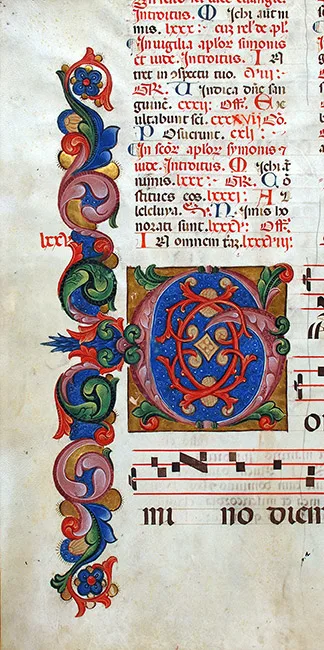
Part of a leaf from a Gradual, in Latin. Italy (perhaps north-west), fifteenth century. Reed MSF25
Colour iconography is most emblematic when described in the context of a specific image, such as the blue mantle of the Virgin Mary (cases 2 and 12) or the red-coloured swaddling cloths of the infant Jesus (case 3). The variety of colours used in the leafy extension of this initial ‘G’ provides a good palette in defining the meaning behind some of the most commonly used hues.
Blue: Signifies Heaven, charity, and wisdom, and is a symbol of the Virgin Mary. Blue is also used as a liturgical colour for the feast of the Immaculate Conception in some churches in Spain, and Central and South America.
Gold: Symbolises wealth, splendour and kingliness. The colour can be used to represent Jesus Christ’s kingly office and the divine light of Heaven.
Green: The symbol of growth, life, hope, fidelity, and immortality. Green is another liturgical colour used on the Sundays after the Feast of the Holy Trinity.
Red: Symbolises love, fervour, holy zeal, and youth, and is connected with blood and martyrdom. It is also a symbol of the Holy Spirit and the Church. The third liturgical colour, red is used in a number of religious rituals including Pentecost, martyr’s days, Thanksgiving, and All Saints’ Day.
Pink: The colour of joy, it is used in the third day (Catholic) or fourth day (Baptist) of Advent.